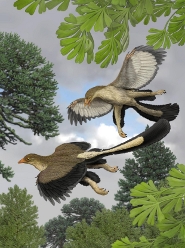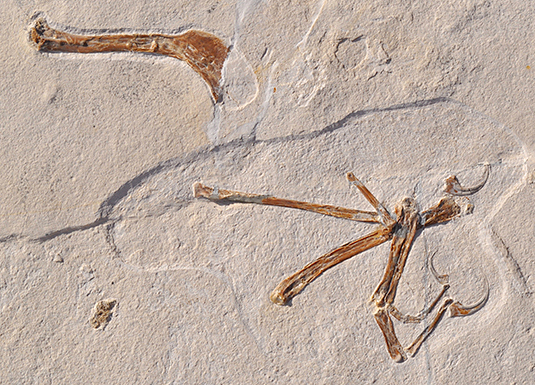A New Jurassic Early Bird Fossil to Rival Archaeopteryx
Alcmonavis poeschli – Another Late Jurassic “Early Bird”
Scientists have identified a new species of “proto-bird” which was contemporaneous with Archaeopteryx (A. lithographica). Known from a single, fragmentary fossil, excavated from the Lower Tithonian Mörnsheim Formation of the Solnhofen Archipelago, the species has been named Alcmonavis poeschli. Its discovery supports the hypothesis that there were numerous bird-like dinosaurs in the Late Jurassic.
The Late Jurassic of Europe Could Have Been Home to Numerous “Proto-birds”
Picture credit: Carl Buell
A Right Wing from a Volant Animal
A. poeschli is represented by a right wing (specimen number: SNSB-BSPG 2017 I 133). The bones are partially dislocated but lying in proximal association, the fossils consist of the humerus, radius, ulna, the hand and finger bones with claws. Although there are only a handful of bones to study, they show a number of derived characters such as a pronounced attachment area for the pectoralis muscle and a robust second finger. These traits indicate that Alcmonavis is a more derived avialan than Archaeopteryx.
A Photograph Showing the Holotype Fossil of Alcmonavis poeschli
Picture credit: Bayerische Staatssammlung für Paläontologie und Geologie/AFP
The photograph (above), shows the wing of Alcmonavis poeschli as it was found in the limestone slab. Alcmonavis poeschli is another example of a volant bird from the Jurassic period. It may have been a more capable flyer than the urvogel (Archaeopteryx). Scars on the wing bones suggest the placement of sizeable muscles, indicating that the raven-sized Alcmonavis was capable of flapping its wings with some force.
Alcmonavis poeschli
One of the authors of the scientific paper, published this week in the academic journal “eLife”, Oliver Rauhut of the Bayerische Staatssammlung für Paläontologie und Geologie (Bavarian State Collection of Palaeontology and Geology) stated:
“At first, we assumed that this was another specimen of Archaeopteryx. There are similarities, but after detailed comparisons with Archaeopteryx and other, geologically younger birds, its fossil remains suggested that we were dealing with a somewhat more derived bird. The wing muscles indicate a greater capacity for flying.”
This discovery indicates higher avialan diversity in the Late Jurassic than previously recognized.
Named after the Altmühl River
The genus name is derived from the old Celtic name for the Altmühl River which flows through the Solnhofen limestone region and from the Greek “avis” for bird. The species name honours Roland Pöschl who leads fossil hunting expeditions to the Old Schöpfel Quarry, where the fossilised wing was discovered.
To read an article published in 2017 about another feathered dinosaur from Solnhofen: The Archaeopteryx That Wasn’t.
To read an article from February 2019, that explains how the iconic Archaeopteryx feather fossil was reclassified: Iconic “Archaeopteryx” Feather Not From Archaeopteryx.
Visit the Everything Dinosaur website: Everything Dinosaur.



